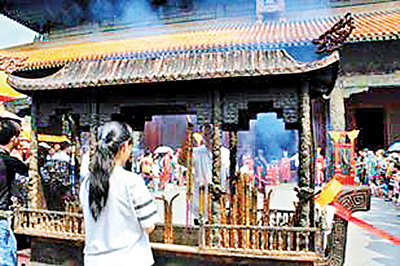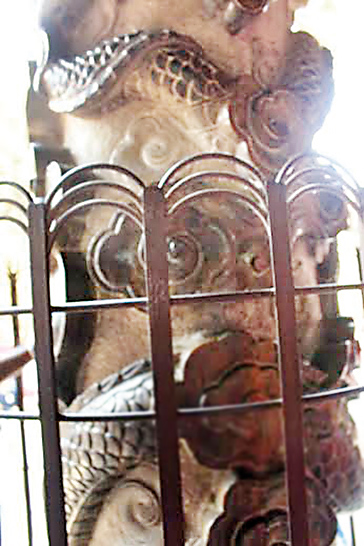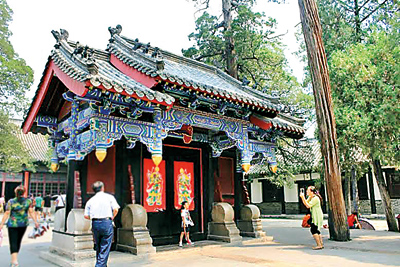Temple, mansion and cemetery: Going back to the era of Confucius
Rickshaws and horse-drawn carriages cruise past a fortified complex standing tall in Qufu in China’s Shangdong Province. This is dedicated to the revered Chinese philosopher, statesman and the founder of Confucianism, Confucius – who advocated a strict code of moral and social values for society.

Venerating a great philosopher: Confucius devotees at the temple
Confucius who was born in 551 BC and died in 479 BC, is known as the Sage Teacher whose philosophy dominated the feudal society of China and generations that came afterwards. Even in present day China, he is considered a role model and greatly venerated.
Qufu – the hometown of Confucius,where his descendants with the ‘Kong’ family name are said to be still living, enjoys worldwide attention as a visit to the temple, mansion and the cemetery of Confucius is truly a profound artistic and cultural experience.
A symbol of traditional Chinese culture, it has been recognised by UNESCO as a World Heritage Site.
The magnificent layout of the temple and mansion complex which was expanded through the successive dynasties of Jin, Yuan, Ming and Qing although destroyed, was renovated several times, in line with ancient Chinese architecture.
On entering the premises (this fortified complex can be accessed via four gates) you may notice a bell and a drum on either side of the gigantic stone fortification.

A carved pillar with dragons coiled around
In ancient times, ringing of the bell during sunrise and beating of the drum at sunset had been a routine practice.
A long row of cyprus and pine trees over seven or eight hundred years old leads to the Temple of Confucius, also known as the Temple of the Supreme Saint.
It is said to have been built one year after the death of Confucius on the orders of Duke Ai of the State of Lu, as a place for praise and worship of Confucianism.
According to the tourist information display boards at the site, the temple premises spans over 1000 metres from north to south, and 150 metres from east to west and consists of nine courtyards, each entered through a grand gateway built by successive dynasties.
Today, the temple houses about 100 buildings from the Jin to Ming dynasties including small pavilions with stone inscriptions of the emperor scholars who passed the examinations based on Confucius theory to become the Members of the State.
The main building of the temple, Dacheng Hall is also known as the Hall of Great Accomplishment. This is where sacrifices to Confucius are offered and here you will see many including young children burning incense to worship the great scholar.
The temple is considered one of the most ancient buildings of China and this yellow tiled-roof structure, supported by opulently decorated pillars, is staggeringly beautiful.
A flight of stone steps and you are greeted by a long verandah with 28 carved pillars with dragons coiled around.
We are told by our tour guide that no building in the city of Qufu is allowed to exceed the height of this building, out of respect for Confucius.
Xingtan pavilion, also known as the Apricot pavilion –is believed to be the place where Confucius lectured his disciples, under an Apricot tree.

The house occupied by Confucius and his mother
Overlooking the pavilion is an incense burner – it is said an incense stick which generally lasted for about an hour was used to keep a track of the time during lectures.
To the east of the temple, you find the Kong family mansion- the house occupied by Confucius and his mother which had been later given an aristocratic touch, adding on extensions throughout the time when Confucius’ family descendants lived and worked there.
The mansion served as the official mansion of each generation of the Duke of Yansheng. (In feudal society the lineal descendants of Confucius who were named the Sacrificial Officials to Confucius, were granted the title of nobility- Duke of Yansheng and they enjoyed special privileges.
Their fiefdom had its own court of law). Accordingly, the family mansion of Confucius was also called the ‘Mansion of Duke of Yansheng.’
Narrow alleys leading up to this architectural combination of living quarters and offices, cover an area of 120 thousand sq. metres.
While a separate meeting place known as the Upper Front Chamber served as a meeting place for the Dukes of Yang Sheng with their relatives and close clansmen during weddings, funerals and other celebrations, the Third Hall, with the reception and waiting room, is where they dealt with family affairs.
The mansion also has a separate hall where the Duke received the Emperor’s decree, met officials and carried out family rules.
A rough, uneven stone slab outside the hall gives an idea of how punishment was meted out to those who broke the family laws. They were made to kneel on the slab for hours in the sun.
The old well and the gutter through which water was carried to the inner apartments have been preserved. It is said that in ancient days, the emperors drank water from this well in the belief that it gave them wisdom.
Step out into the garden from the mansion and a long pathway through a forest leads to the place where Confucius and his descendants were laid to rest. Covering about 183 hectares, the cemetery is said to contain more than 100,000 graves of Confucius’ descendents.
While you can stroll around the cemetery on foot, buggy carts also operate at a reasonable cost. Most visitors stop at Confucius’ tomb which is in a quiet corner of the graveyard to offer garlands and flowers.
A visit the temple, mansion and the cemetery of Confucius in essence, is an insight into the historical, cultural, political and administrative system of the great philosopher’s day.
A visit to Qufu which can be accessed via high speed train from Beijing would mean setting aside the better part of a day but it is certainly worth it.


